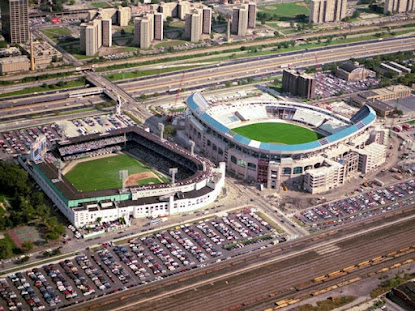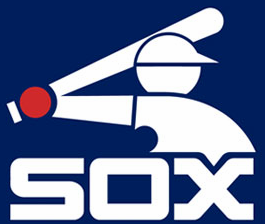The History of the Chicago White Sox - Part 11
Everything that could change about the Chicago White Sox did change in the early nineties. Everything except the team’s name and location. Then-Speaker of the Illinois House Mike Madigan made sure of that. He couldn’t get the votes for the stadium deal until 12:03 am on June 2nd, but the bill was declared passed at 11:59 pm on June 1st. Reporters asked him about the discrepancy, and he responded by saying “When the speaker says what time it is, that’s what time it is.”
From The Spongebob Squarepants Movie (2004):
Perch Perkins: First of all, congratulations, Mr. Krabs.
Mr. Krabs: Hello, I like money.
Perkins: What inspired you to build a second Krusty Krab right next door to the original?
Mr. Krabs: Money.
Comiskey Park II, later renamed U.S. Cellular Field, and re-renamed to Guaranteed Rate Field, cost the taxpayers 200 million dollars. These things always feel like shakedowns. Like Jerry Reinsdorf bought the White Sox and then left a message on every Chicago resident’s answering machine that says “meet me in Springfield with 200 million dollars if you ever want to see your beloved baseball team again”. Threatening to move the team is a classic move that has been done year after year across all four big North American sports leagues. It’s a classic because it works. The people have deep emotional investments in their teams and politicians know that it would be career suicide if they let a team leave. Owners talk constantly about the jobs that the team creates, and the tourism revenue that they bring, but economists agree that these massive publicly funded stadiums almost never work out. Nearly every single time it just results in tax money going towards the personal wealth of billionaires. Chicagoans should be used to it.
The timing of its opening was really unfortunate. It opened in 1991, and was built according to the trends of the time. In 1992, Oriole Park at Camden Yards was opened, one of the most beautiful baseball stadiums in the country, immediately ushering in a new era of baseball stadium design and architecture that has resulted in the creation of masterpieces such as Oracle Park in San Francisco (opened in 2000) and PNC Park in Pittsburgh (2001). Comiskey Park II was outdated almost from the moment it was completed. Extensive renovations were done to the stadium from 2001 to 2007 (at taxpayers’ expense) in order to bring it more in line with modern architectural trends.
As someone who has spent a lot of time in this stadium and made a lot of childhood and adult memories in it, I can say that it’s… fine. The stadium does its job, it gives the team a place to play and the fans a place to watch, but it’s incredibly boring. There is nothing notable or interesting about this stadium at all. It feels like the default stadium that comes up when you open the stadium builder in MLB The Show. When I was a kid, I had a book about baseball that included one interesting fact about every MLB stadium. When it got to the White Sox, the fact that it chose to present was that the stadium has a shower in it in center field for fans to cool off on hot days. Perhaps the most interesting part of the field is that it works. It’s not a bad stadium. All of the plumbing works, it’s easy to access for fans, the food is absolutely incredible, probably the best in all of baseball, and the locker rooms are nice enough. It’s fine. It works. The tax bill still hasn't been paid off, by the way.
Another thing that changed in the early nineties was the team’s logo and colors. That was nothing new for the team. They’d churned through logos and identities ever since they were created.
In 1990, though, the White Sox struck gold.
The average MLB logo lasts 11 years, and the current White Sox one has just started its 25th with no signs of going away anytime soon. The current White Sox logo is a cultural icon, and the black-heavy color scheme has been incredibly popular. The current logo has managed to take on a life of its own outside of sports, something that no other White Sox logo, and very few sports logos, have been able to do. This White Sox logo, and specifically the on-field hat, was picked up by the group N.W.A, and grew from there to become an icon of 90s rap and a symbol of black culture.
Time for the disclaimer. This is an extremely difficult part of this to write. It’s not exactly my place for me, a white guy from the suburbs, to explain to you what the White Sox hat means to black culture. I am writing about cultures that I am not a part of and have only seen from the outside.
Easy-e was the first big champion of the hat. The rest of N.W.A started wearing it not long after. By 1991, the White Sox were third in MLB in merchandise sales. Dr. Dre’s album The Chronic released in 1992, featuring the song “Nuthin' but a 'G' Thang”. The song hit #2 on the Billboard Hot 100, and Dre wore a White Sox hat through the whole music video. Tupac, Puff Daddy, Nas, Lil’Wayne, Jay-Z, and Common all have worn White Sox hats. It was considered iconic not long after, and today, it shows up everywhere.
It’s incredible how much music has shown up in this blog. Specifically, I want to take us back to Disco Demolition Night. A violent riot born out of a hatred for disco music, but also made worse by alcohol and mob mentality. Disco was seen at the time as black music. The hatred of disco and anger at how it was replacing rock n roll was, at least partially, an opposition to the idea of any element of black culture becoming mainstream. We’ve gotten from that to this. The demographics of the south side had changed, too. When the White Sox were first founded, the south side was very irish-heavy, but over the next 90 years, would become an african-american majority community. The White Sox have gone from being the setting for a rejection of black culture to embracing and representing it.
That’s a lot of what changed in the nineties. It was more than just the stadium or the clothes. A big shift was in who the White Sox were, and what they represented.
As for the team on the field, that was changing, too.
It was changing a lot.







Comments
Post a Comment